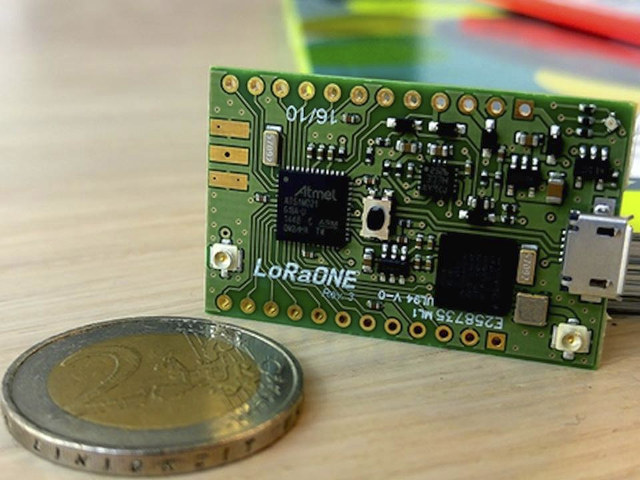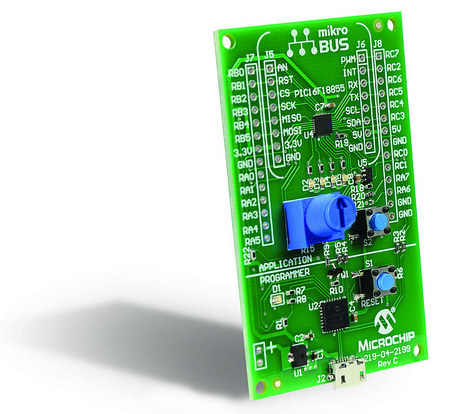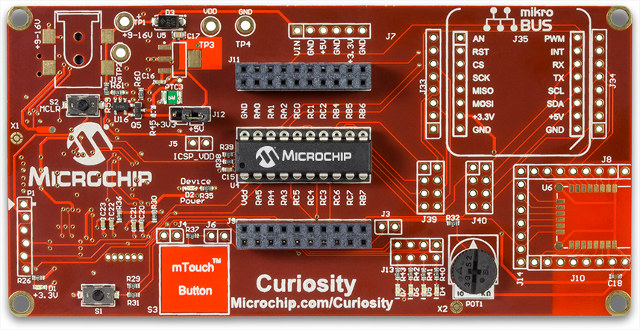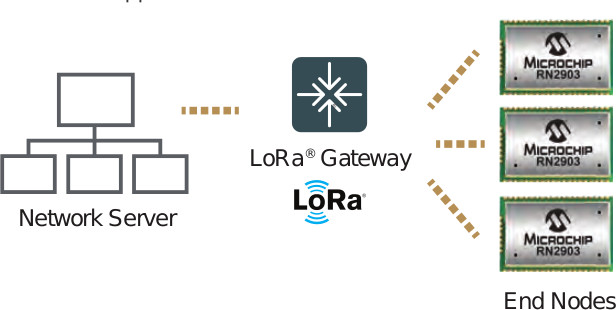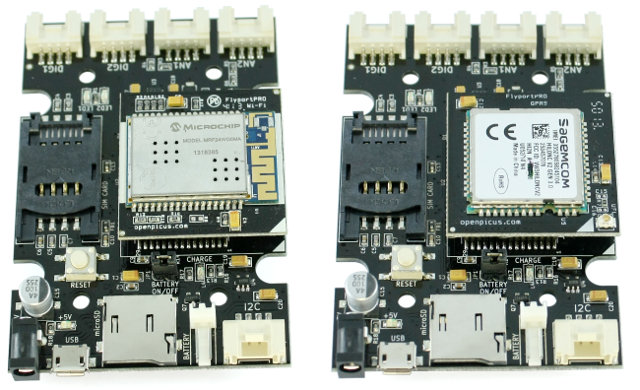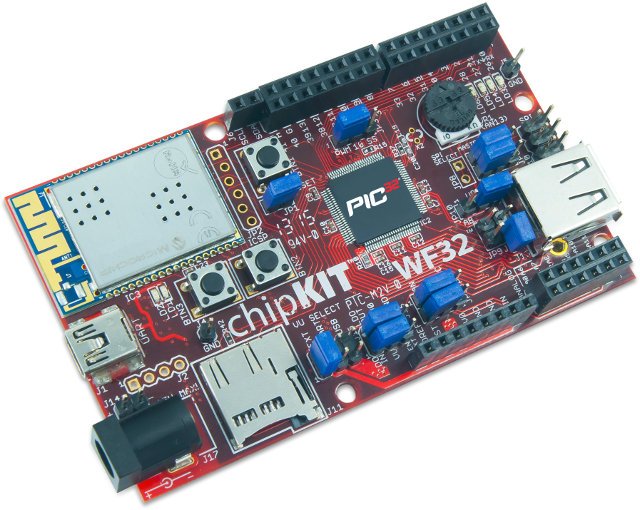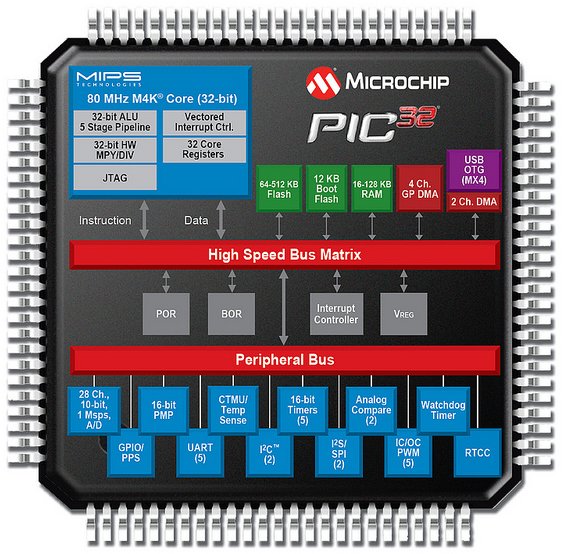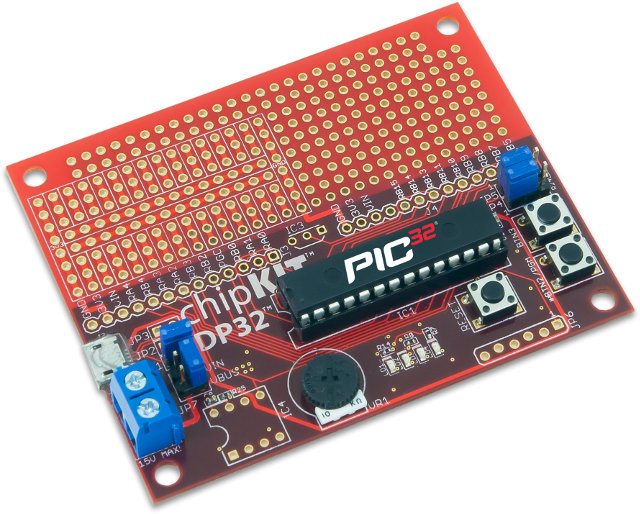While there are many long range LPWAN standards, LoRa appears to be one of the most popular with boards such as LoPy, and now SODAQ LoRaONE module hitting crowdfunding campaigns. LoRaONE is powered by an Atmel Cortex M0+ micro-controller, features Microchip RN2483 or RN2903 LoRaWAN module, GPS, and various sensors. LoRaONE board specifications: MCU- Atmel ATSAMD21G18 ARM Cortex M0+ micro-controller @ 48 MHz with 256 KB flash memory, 32KB SRAM, and up to 16 KB EEPROM (by emulation) Connectivity LoRa via Microchip RN2483 (433/868 MHz) or RN2903 (915 MHz) module depending on your region GPS via u-blox EVA 7M USB – 1x micro USB port for power and programming Expansion headers (unpopulated) 14x digital pin, 12x for analog and 8x for PWM, plus UART, SPI and TWI (I2C) Analog output pin – 10-bit DAC External Interrupts: Available on all pins DC Current per I/O pin: 7 mA Operating Voltage – […]
Microchip Introduces MPLAB Xpress Cloud-based IDE and MPLAB Xpress Evaluation Board
Microchip has just launched MPLAB Xpress online IDE with some of the most used features of the company’s MPLAB X IDE, as well as a free – in limited quantities – MPLAB Xpress evaluation board based on a PIC16 micro-controller. Let’s get through the development board specifications first: MCU – Microchip PIC16F18855 MCU with 14KB flash, 1KB SRAM, 256 bytes EEPROM USB – micro USB port for power and programming Expansion Headers Unpopulated mikroBUS header supporting one of 180 Click boards Unpopulated 2x 14-pin header with GPIOs, I2C, SPI, UART, ADC, etc… Misc – Reset button, user button, potentiometer Dimensions – N/A Playing with hardware is always more fun, but if you just want to evaluation the online IDE, you don’t even need the board. Visit MPLAB Xpress Code Examples page, load one of the example, possibly log-in if you want to save changes to the 10GB free online storage […]
$15 Microchip Curiosity Development Board Supports 8-bit PIC Microcontrollers
I’ve just found out Microchip had introduced Curiosity development board a little while ago, in order to let students and others experiment with their 8-bit PIC DIP MCUs, and including MikroElectronika Mikrobus footprint, an interface for Microchip RN4020 module to add Bluetooth Low Energy, as well as other headers and some extra features like buttons, and a potentiometer. Microchip Curiosity board specifications: MCU – PIC MCU socket for 8, 14, and 20-pin micro-controllers with PIC16F1619 pre-installed. Expansion mikroBUS Click Board footprint Microchip RN4020 Bluetooth Module Footprint USB – USB mini-B connector Misc – Master Clear Reset button, potentiometer, LEDs, mTouch button, push button Power Supply 5V via USB 9V using an external power supply (footprints only) 3.3V to 5V external power supply via TP3 and TP4 pins Dimensions – N/A There are over 160 MikroElektronika Click boars on the market now, but only seven are listed with code samples for […]
Microchip Introduces $11 RN2483 & RN2903 LoRa Modules and $70 LoRa Evaluation Kits for IoT & M2M Applications
LoRa is one of those long range low power WAN standards used for the machine to machine (M2M) and Internet of things (IoT) applications. I already featured a Semtech Lora module here with a line-of-sight range of up to 20 to 30km, and the company has just partnered with STMicro to deploy LoRa solutions, but today, I’m going to have a look at Microchip Lora modules and development kits that I discovered in the company’s Micro Solutions Nov/Dec 2015 publication. The company has launched two modules for the European and North American markets with respectively RN2483 LoRa 433/868 MHz R&TTE Directive Assessed Radio Modem and RN2903 915 MHz North American modem. Apart from the different frequencies, both modules have similar features: On-board LoRaWAN Class A protocol stack Tx/Rx Power RN2483 – 40 mA (14dBm, 868MHz) Tx, and 14.2 mA Rx @ 3.6V RN2903 – 124 mA Tx max, and 13.5 mA […]
openPicus Introduces Wi-Fi and GPRS IoT Kits Powered by Microchip PIC24 MCU
openPicus has launched two new development kits for the Internet of Things with either Wi-Fi or GPRS connectivity, based on their FlyportPRO modules featuring a 16-bit Microchip PIC24 MCU, and sharing the same baseboard. These kits can be used as a Web server with firmware update over the air (FOTA) (Wi-Fi version only) among other things, and support TCP, UDP, FTP, & HTTP protocols, as well as MQTT (Message Queue Telemetry Transport), a light weight messaging protocol running on top of the TCP/IP protocol, used when a small code footprint is required and/or network bandwidth is limited. openPicus FlyportPRO Wi-Fi and GPRS modules share mostly the same specifications: MCU – Microchip PIC24FJ256GB206 16-bit MCU @ 32 MHz with 256KB Flash, 96KB RAM External Storage – 16Mbit Flash memory (for FOTA), 64Kbit EEPROM Connectivity GPRS Module – SAGEM HILONC GPRS Transceiver (quad band: 850, 900, 1800, 1900 MHz) with uFL connector for external […]
Microchip Unveils chipKIT Wi-Fi Development Board and Motor Control Shield
Microchip Technology has just announced two new boards by Diligent, part of its Arduino compatible chipKIT ecosystem: chipKIT WF32 board featuring a PIC32 MCU and a Wi-Fi module, and chipKIT Motor Control Shield for servos, steppers, and DC motors. chipKIT WF32 Development Board Board specifications: MCU – Microchip PIC32MX695F512L micro-controller (80 Mhz 32-bit MIPS, 512K Flash, 128K SRAM) External Storage – Micro SD card connector Wi-Fi – IEEE 802.11 b/g via Microchip MRF24WG0MA WiFi module USB – USB 2.0 OTG controller with A and micro-AB connectors for debugging and programing. 43 available I/O pins with 12 analog inputs Misc – 4x user LEDs PC connection uses a USB A > mini B cable (not included) Power – 7V to 15V input voltage (recommended), 3.3V operating voltage, 30V input voltage (maximum), 0V to 3.3V analog input voltage range Microchip has also released an embedded cloud software framework to create Internet of Things […]
Microchip Announces New PIC32MX3/4 32-bit MCUs Based on MIPS M4K Core
Microchip Technology has just announced a new family of PIC32MX3/4 MCUs featuring a MIPS M4K core @ 80 MHz, coupled with 16 to 128KB RAM, 64 to 512KB flash, that are designed to be used in connectivity, graphics, digital audio and general-purpose embedded control. Microchip PIC32MX3/4 32-bit micro-controllers have been available for several years, but the company added 7 new MCUs with more memory, higher integration of peripherals, and lower cost. PIC32MX3/4 key features are as follows: MIPS M4K core @ 80 Mhz with 105 DMIPS performance (equivalent to Cortex M3 MCU @ 84MHz), 16 to 128KB RAM, 64 to 512KB flash, and 12KB boot flash. 4 channel GP DMA, 2 channel DMA I/O: 28 channels 10-bit ADCs 5x UARTS, 2x I2C, 2x I2S/SPI, GPIOs 5x PWM 16-bit parallel master port (PMP) Charge Time Measurement Unit (CTMU)/Temperature Sensor 5x 16-bit timers, watchdog timer, Real-time clock USB OTG (MX4 family only) […]
Microchip Unveils 2 Arduino Compatible Boards, and a Prototype-Friendly PIC32 MCU
Microchip Technology has announced several new tools, expanding its Arduino compatible chipKIT platform ecosystem, based on Microchip’s 32-bit PIC32 microcontrollers (MCUs) available in low pin count SOIC or SPDIP packages. Digilent’s chipKIT DP32 board features basic I/O and interface components, including a prototyping aera, user buttons, and a potentiometer. The board (part # TDGL019) costs $23.9, and should be available on May 17 at microchipDIRECT. The chipKIT Fubarino Mini board, from a partnership between FUBAR Labs and Schmalz Haus, provides another option for Arduino-compatible development with 32-bit PIC32 MCUs, using a smaller form factor. The board is supposed to be available today for $19.95 on microchipDIRECT, but I could not find it yet. If you don’t want/need a development board, the company also provides PIC32MX250F128B MCU in PDIP package (28-pin) preprogrammed with chipKIT USB Bootloader. This MCU, clocked up to 40Mhz, includes 128 KB Flash and 32 KB RAM, as well […]


